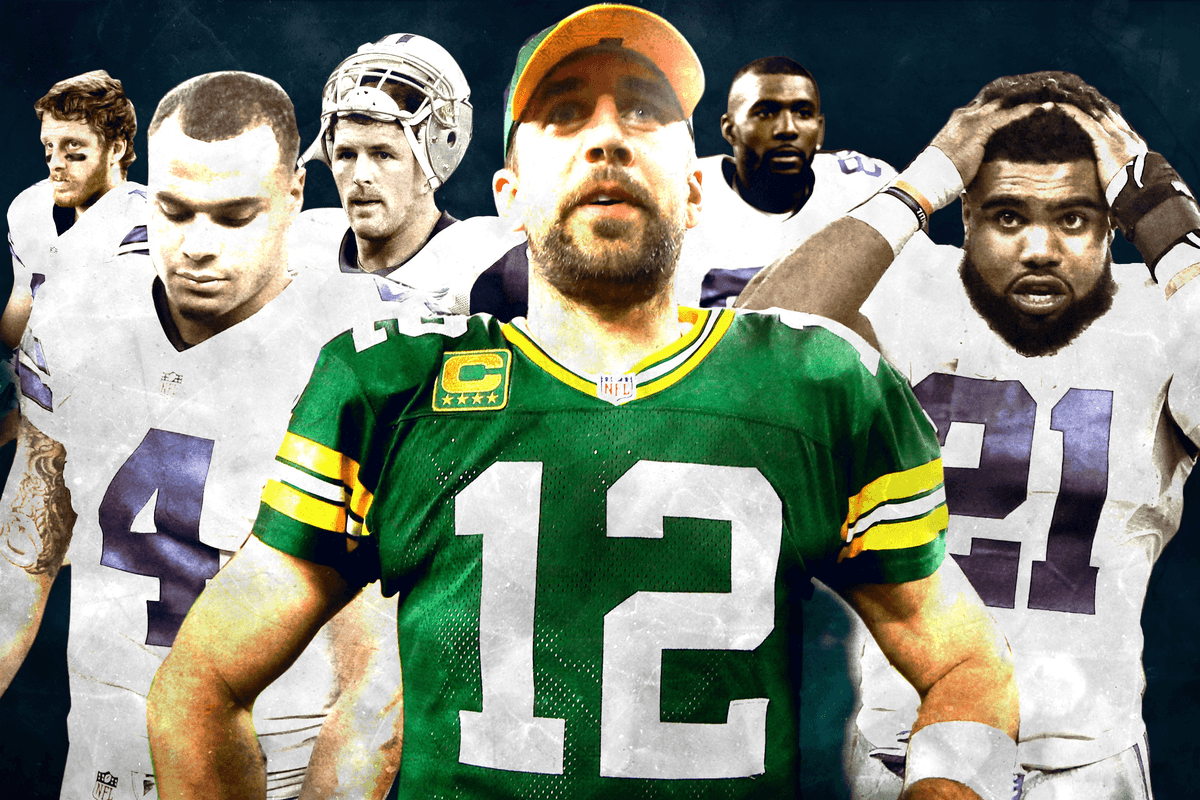
There are games that feel like classics before they’re even over, and Sunday brought one of them. When Dak Prescott hit Dez Bryant over the middle for a 7-yard touchdown to slice the Packers’ lead to 28–26 late in the fourth quarter — all but capping an 18-point rally that had seemed unthinkable an hour earlier — the Green Bay–Dallas thriller officially became one of those games, the sort we’ll talk about years from now when parsing the legacies of the men who shaped it.
An instant classic can take many forms: the furious comeback; the haymaker-trading shoot-out; the iconic, improbable mini-miracle. The Packers’ 34–31 divisional-round win was all of those, a Frankenstein’s monster of greatness. When Green Bay raced to a 21–3 advantage midway through the second quarter, it seemed as if the upstart Cowboys had been punched in the mouth by a moment and a magician they weren’t ready to handle. Aaron Rodgers had the Dallas defense on a string for the first 23 minutes of action, picking up right where he left off a week after toying with a Giants group that ended the regular season as the best unit in football.
Rodgers’s display against Dallas — and the late-game heroics it would involve — was the next moment in what’s gradually becoming his time, a months-long feat that could earn him a place in the quarterback pantheon. Getting there, though, meant fending off a young, unflinching bunch that refused to go quietly.

The Cowboys’ answer to Rodgers’s third touchdown drive in as many tries took only four plays and 94 seconds, punctuated by a 40-yard heave from Prescott to Bryant. Against a Packers secondary that had been regularly thrown into the deep fryer all season (and a Rodgers-led offense that was scoring at will), Dallas had to hit a few of those shots Sunday; the toss to Bryant was one of eight Prescott completions of at least 15 yards, and the second of that drive.
Bryant saved his best game of the season for the time when Dallas needed him most, and watching the connection between him and Prescott blossom with their season hanging in the balance was a thing of beauty. Bryant racked up nine catches for 132 yards, both season highs.
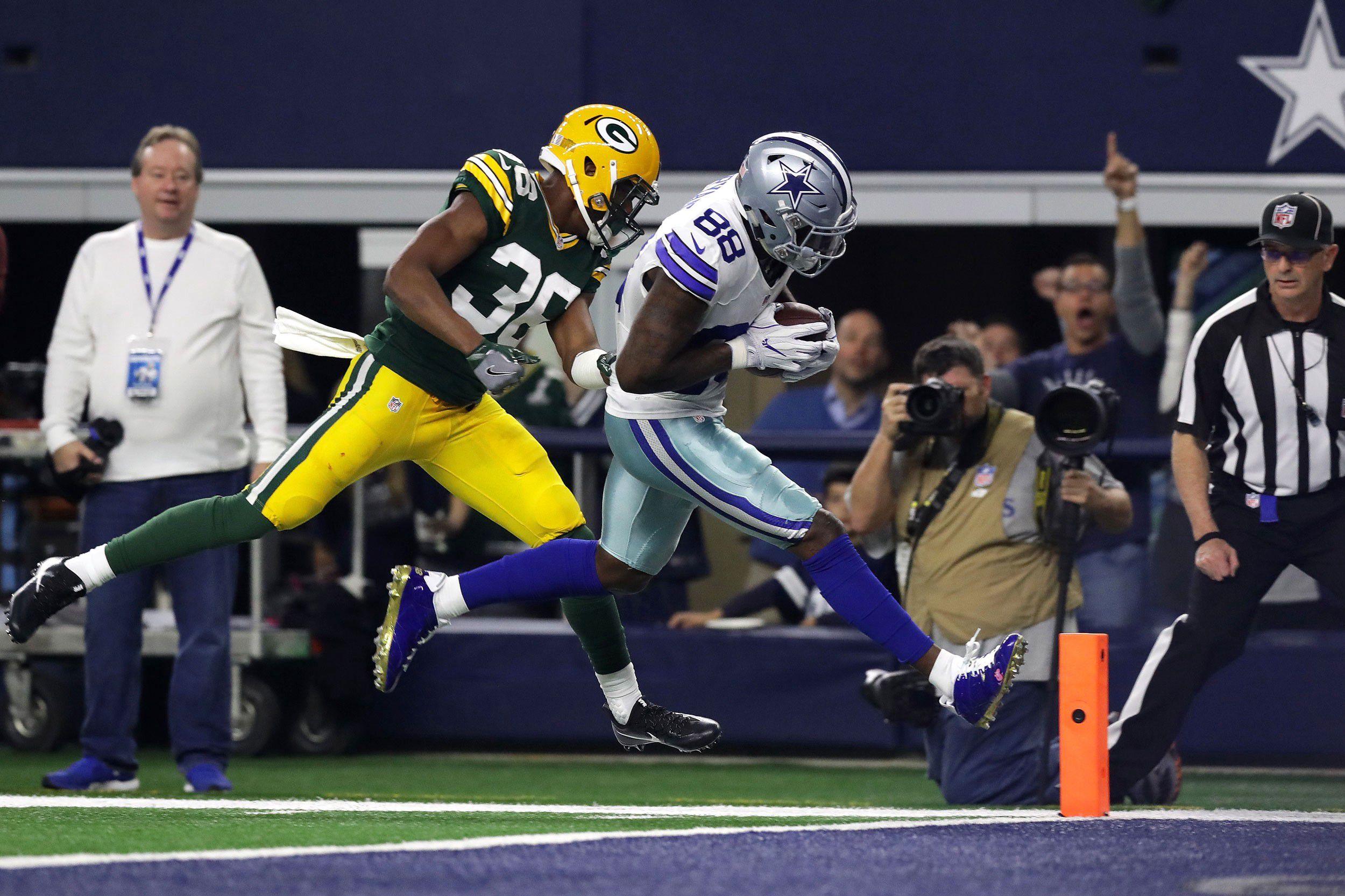
Prescott and Ezekiel Elliott each had their own flashes of brilliance as the Cowboys clawed back against Green Bay, the first of what will likely be many memorable playoff flourishes. On the fourth-quarter drive that tied the game, Prescott made a handful of highlight-reel throws, starting with a 15-yard toss off his back foot that perfectly led Bryant to open space near the sideline and ending with a masterfully placed play-action slant to get Bryant into the end zone. Elliott, meanwhile, was ruthlessly efficient all afternoon, ripping off 125 yards on 22 carries, a dozen going for at least 5 yards. Separating Elliott’s impact as a rookie from the play of his excellent offensive line is never easy (and both center Travis Frederick and right guard Zack Martin had stellar games Sunday), but he made plenty of runs against the Packers that had nothing to do with the beasts blocking for him. There are still scorch marks on the Jerry World turf where Elliott spun Clay Matthews out of his socks to set up Bryant’s game-tying score.
Despite the way things ended, the past five months couldn’t have gone much better for the Cowboys’ franchise and future. The charmed run that owner Jerry Jones’s team began after dropping its opener to the Giants was unlike anything it could have imagined in the wake of watching Tony Romo crumple into a heap during a preseason game in Seattle.
The Cowboys may be watching from home next week (and really, who’d blame them if they didn’t?), but Prescott, Elliott, and Co. made Dallas the defining team of the 2016 season. As NFL television ratings floundered this fall, the Cowboys became appointment viewing, and with their young backfield and soul-crushing offensive line in place for years to come, even this loss felt more like the beginning than the end.
Still, none of that makes Sunday’s finish any less devastating. Kickers Mason Crosby and Dan Bailey traded 50-plus-yard, moonshot field goals in the final two minutes, the sort of steel-nerved, I-can’t-watch-this plays upon which classics are built. Even as Bailey’s 52-yard rocket blast sailed through the uprights, though, it was hard not to think that Dallas had left too much time on the clock.

Sunday’s epic may have been the start of something for the Cowboys, but for Rodgers it was the next step in what he’s been constructing since late November. His run-the-table decree following the Packers’ humiliating, nationally televised, 42–24 loss to Washington in Week 11 was met with scoffs. Sure, Aaron. Whatever you say. Since then, basically every Rodgers throw has been engulfed in flames, singeing all the opposing defenses in his path while carrying Green Bay to eight straight wins.
It was clear from the start that this playoff game would bring more of the same. My notes on Rodgers’s third-and-7, on-the-move strike to Jared Cook to keep the Packers’ second touchdown drive afloat just read: “Get the fuck out of here.”
During this Green Bay run, throws like that — which should make us reconsider what we know about the natural laws of the universe — have become the norm. Rodgers is now to the rest of the league what he’s been to teams in the NFC North for years. He’s the very thing you fear after turning out the lights.
This Packers triumph wasn’t a spotless Rodgers performance. He threw his first interception since Week 10, ending a stretch that had included 24 touchdown passes without a pick. He also felt the absence of veteran receiver Jordy Nelson, particularly on a few schoolyard routes to rookie wideout Geronimo Allison.
Yet when Rodgers trotted onto the field with 35 seconds remaining, no one watching could claim they didn’t expect (or dread) another bit of sorcery. After Rodgers completed a well-timed screen pass to Ty Montgomery for a 17-yard gain, Cowboys safety Jeff Heath (the same player who picked off Rodgers in the third quarter) sacked the quarterback for a 10-yard loss, a play that should have ruined Rodgers’s moment. All it did was enhance it.
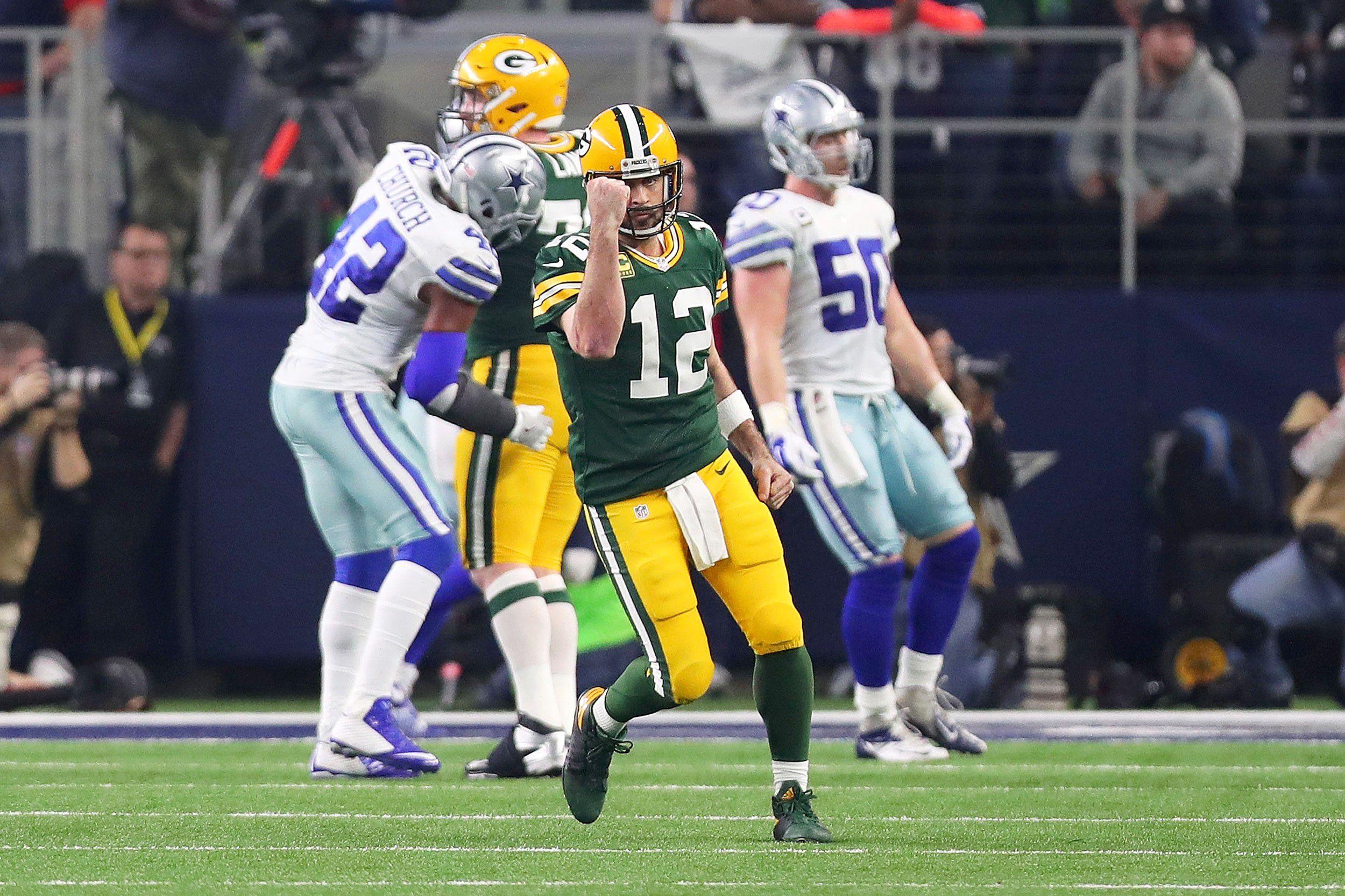
The throw that Rodgers made to Cook along the left sideline — the spinout, bouncing-to-his-left laser the likes of which no one on earth is capable of making — will go down as one of the best in playoff history. Every new replay and angle serves only to make it seem more improbable. As Packers receiver Randall Cobb said after the game, on the heels of admitting that Rodgers had simply drawn up the play in the dirt, “It’s magic.”
The Packers are still two wins away from hoisting the Lombardi Trophy, but given the way Rodgers is playing, it’s starting to feel like we’re watching one of the most talented quarterbacks ever make his rise to become one of the greatest. If Green Bay can knock off Atlanta in the NFC title game and go on to steal a Super Bowl win — almost three months after dropping to 4–6 — the Packers’ recent playoff failings will be all but forgotten, and Rodgers will have painted his masterpiece.
One classic is in the books. Two to go.
The Starting 11
A look at 11 big story lines, key developments, and interesting tidbits from this week in the NFL.
1. The Patriots are great at creating mismatches on offense, whether through personnel packages or individual skill sets. New England’s second drive in its 34–16 win over the Texans was a telling example of what its offense is constantly aiming to accomplish. After a 30-yard pass interference penalty gave the Pats the ball on Houston’s 35-yard line, they came out with a heavy package that included Martellus Bennett, blocking tight end Matt Lengel, and fullback James Develin.
One of offensive coordinator Josh McDaniels’s go-to tricks is using this type of run-first formation as a way to hunt for big gains down the field with play-action. And that’s exactly what the Patriots did. Following a quick play fake to LeGarrette Blount, Tom Brady uncorked a 22-yard throw to Chris Hogan — the formation’s lone wide receiver — down the right sideline.
The Patriots followed that up with a play designed for Dion Lewis near the goal line. At the snap, Lewis bolted from the backfield into the left flat, where his speed proved too much for Houston inside linebacker Benardrick McKinney. Brady flipped the ball to Lewis, who turned upfield and snuck inside the pylon for an easy 13-yard score. Picking on McKinney was a pillar of the Patriots’ game plan on Saturday; he was also the victim on James White’s nasty hesitation wheel route that led to a 19-yard touchdown early in the third quarter. New England had far from its best performance in the divisional round, but even in a down game it showed it can hammer away at a defense’s weaknesses enough to eventually inflict some damage.
2. The Texans defense had some wrinkles of its own, and most involved Whitney Mercilus absolutely wrecking shop. Watching Mercilus the past two weeks was a fun reminder of what can happen in the playoffs. The Houston fifth-year linebacker-edge rusher-boogeyman was great throughout the 2016 regular season, but he turned into a total game wrecker against the Raiders and Patriots.
As a pass rusher against New England, he did the bulk of his damage as a stand-up linebacker situated in the A gap, a tactic Bill Belichick mentioned that the Texans could use last week. Mercilus smoked Patriots center David Andrews twice, the second time by way of a wicked spin move that probably has Andrews still searching for his shoes.
While Mercilus is most dangerous getting after quarterbacks, he also made a play in coverage that required him to run down Lewis nearly 30 yards past the line of scrimmage. He followed that up by destroying Lewis on a 1-yard gain in the second quarter, a stop on which Mercilus spilled back inside to make the tackle. That’s an array of responsibilities not many guys in the league are even asked to attempt.
Expect the Steelers to salivate when watching the success Mercilus had as an interior rusher. No team enjoys sending its inside linebackers after the quarterback quite like Pittsburgh. Both Lawrence Timmons (third) and Ryan Shazier (fifth) rank in the top five for pass-rush snaps among move linebackers, and the pair combined for six sacks during the regular season.
3. The scariest version of the Patriots’ Rob Gronkowski–less offense surfaces when Julian Edelman gets going. I’m not sure Edelman has ever hit the 100-yard receiving plateau in a weirder way than he did Saturday. For most of the first three quarters, the difference in the game was the trio of deep shots that New England pulled out of its ass. Each came on a desperation toss that involved a Pats receiver (Edelman twice, Chris Hogan the other time) tracking a jump ball and bailing out Brady.
Edelman’s two snags accounted for 74 of his 137 yards, but ideally that’s not how the Patriots want him to affect a game. The Brady-Edelman connection they’re after came on New England’s second drive of the second half, when Brady hit his favorite target four times for 54 yards on mostly timing routes that emphasized Edelman’s ability to create quick separation.
The chunks of yardage Edelman chewed up in the first half helped keep the Patriots afloat while their offense struggled; the back-shoulder, borderline unstoppable catches like the one above are where he’s most valuable.
4. Matt Ryan got rid of the ball in a hurry Saturday, but his offensive line did work, especially during the Falcons’ final drive of the first half. Seattle’s Michael Bennett snapped at a reporter following Atlanta’s 36–20 victory over the Seahawks in explaining how quickly Ryan got the ball out of his hand. As Pro Football Focus’s Nate Jahnke observed, Bennett had a point, but Ryan’s line held up long enough for the Falcons receivers to shake loose on some slower-developing routes during the drive that turned the game into a blowout.
Watch that clip again. That’s some damn fine work. Ryan’s MVP-worthy season, coordinator Kyle Shanahan’s anointment as a play-calling genius, and Atlanta’s array of offensive playmakers will dominate the conversation leading up to the NFC championship game, but the addition of center Alex Mack and the overall improvement of the group up front may be the most crucial difference between this season’s Falcons and the 2015 version.
5. Atlanta’s response to Richard Sherman shadowing Julio Jones was repeatedly sending Jones toward the middle of the field; it made for a matchup that Jones won in a landslide. That’s no slight to Sherman. Sticking with Jones is a brutal task for any corner, and taking Sherman away from the boundary (where he’s especially effective) made life tough for the Seattle standout. The Falcons went to Jones early and often on in-breaking routes, including three times in the first half.
Moving a hulking star receiver all over the formation to combat a tall, physical corner like Sherman may seem like a simple solution to a tough predicament, but the ease with which Jones alters the game is uncommon for a guy with his build. Most 6-foot-3, 220-pound receivers lack anything close to the flexibility and quickness that Jones has. They just don’t make ’em like this very often.
6. Losing right guard Germain Ifedi was the deathblow for an already-shaky Seahawks offensive line. When Ifedi went down with an ankle injury at the 10:49 mark of the first quarter, Seattle’s offensive hopes were all but dashed. Backup Rees Odhiambo was outmatched all afternoon. He mishandled a stunt that allowed Falcons linebacker Brooks Reed to come free for an easy second-quarter sack, and on the safety that helped swing Saturday’s game, it was Odhiambo who stepped on Russell Wilson’s foot after being pushed back by Atlanta defensive tackle (and backup center) Ben Garland. The Seahawks entered the 2016 season with an offensive line held together by Popsicle sticks and chewing gum. Ultimately, it cost them.
7. Sunday night was the purest possible distillation of the Andy Reid Experience. Much of Reid’s game plan against an increasingly stingy Steelers defense was beautifully orchestrated. Consistently putting Tyreek Hill in motion as a way to influence Pittsburgh’s linebackers and negate the speed of a defender like Shazier was the ingenious design we’ve come to expect from the Kansas City coach. Yet equally expected was the Chiefs’ complete botching of the final minutes in a 18–16 Steelers win.
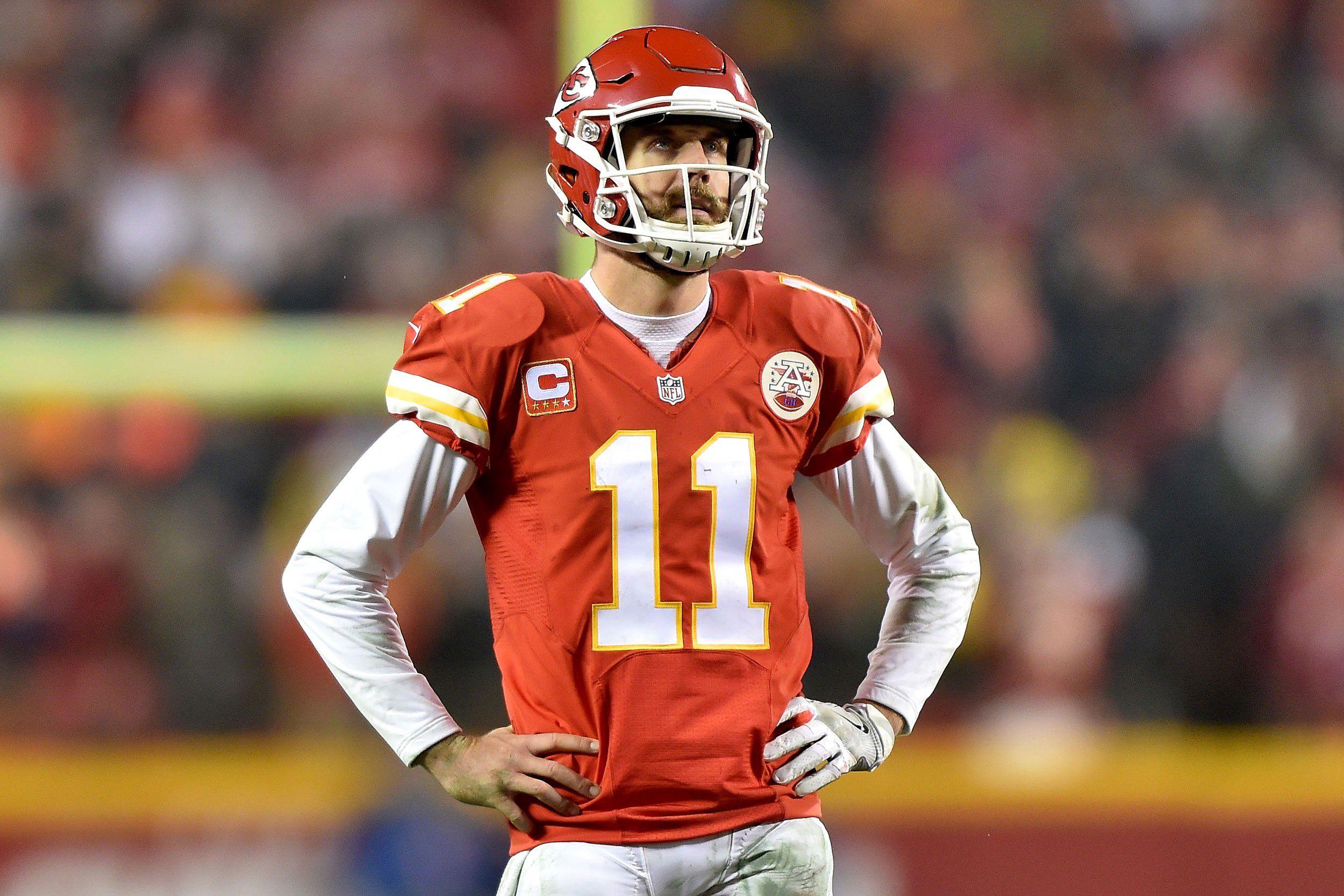
My buddy Bill Barnwell pointed this out on Twitter, but it bears repeating: Kansas City’s handling of its last drive was the exact wrong way to treat an eight-point deficit. Teams typically have two-point-conversion success rates that hover around 50 percent; the ones that act as if they’re guaranteed to erase an eight-point hole with one score can run into what the Chiefs did in this loss. Their lumbering fourth-quarter march toward the end zone took more than seven minutes; out of nine plays that started with the clock running, Kansas City snapped the ball with less than 10 seconds remaining on the play clock eight times.
Reid wasn’t done. Following an incomplete pass on third-and-2 from the Steelers’ 4-yard line, Reid used the Chiefs’ second timeout to set up his fourth-down play. Wanting to draw up the perfect approach at the season’s most crucial juncture is fine; using a timeout while trailing in the game’s final minutes — with the clock stopped — is less so.
Kansas City did manage to put the ball in the end zone, but after an Eric Fisher holding penalty negated a successful two-point try, the Chiefs failed to convert their second attempt. So trailing by two with 2:43 to play and only a single timeout remaining, Reid would try an onside kick to at least give his team a chance to regain possession, right? Not so much. Cairo Santos booted his kickoff to the Pittsburgh 7-yard line; the Chiefs wouldn’t see the ball again.
I can’t imagine how maddening it must be to root for a Reid-coached team. Over the past 20 years, he’s proved time and again that he’s a brilliant football mind who is adored by his players. But these clock-management snafus continue to haunt him.
8. Getting edge rusher Bud Dupree back from the injured reserve has been a coup for the Steelers defense. The 2015 first-round pick has been a reliable force since his Week 11 return from a core muscle tear, and he forced an interception in Sunday’s victory over the Chiefs. Dupree is far from reaching his ceiling as a pass rusher, but Pittsburgh adding a guy with Dupree’s athletic profile (I didn’t realize how absurdly twitchy he is; I mean, look at this) for the stretch run has made a huge difference up front.
9. Fully healthy and totally intact, the Steelers offensive line (and this guy named Le’Veon Bell) is fueling Pittsburgh’s playoff run. Much has been made about Bell, Ben Roethlisberger, and Antonio Brown finally playing together in the playoffs, but this is also a rare instance when the Steelers line has managed to avoid major injuries. Last season, the unit lost center Maurkice Pouncey to a broken leg in the preseason and then left tackle Kelvin Beachum (now with the Jaguars) to a torn ACL in Week 6. In 2013, Pouncey was lost in Week 1 to a knee issue. The season before that, knee problems cost guard David DeCastro the first half of the year.
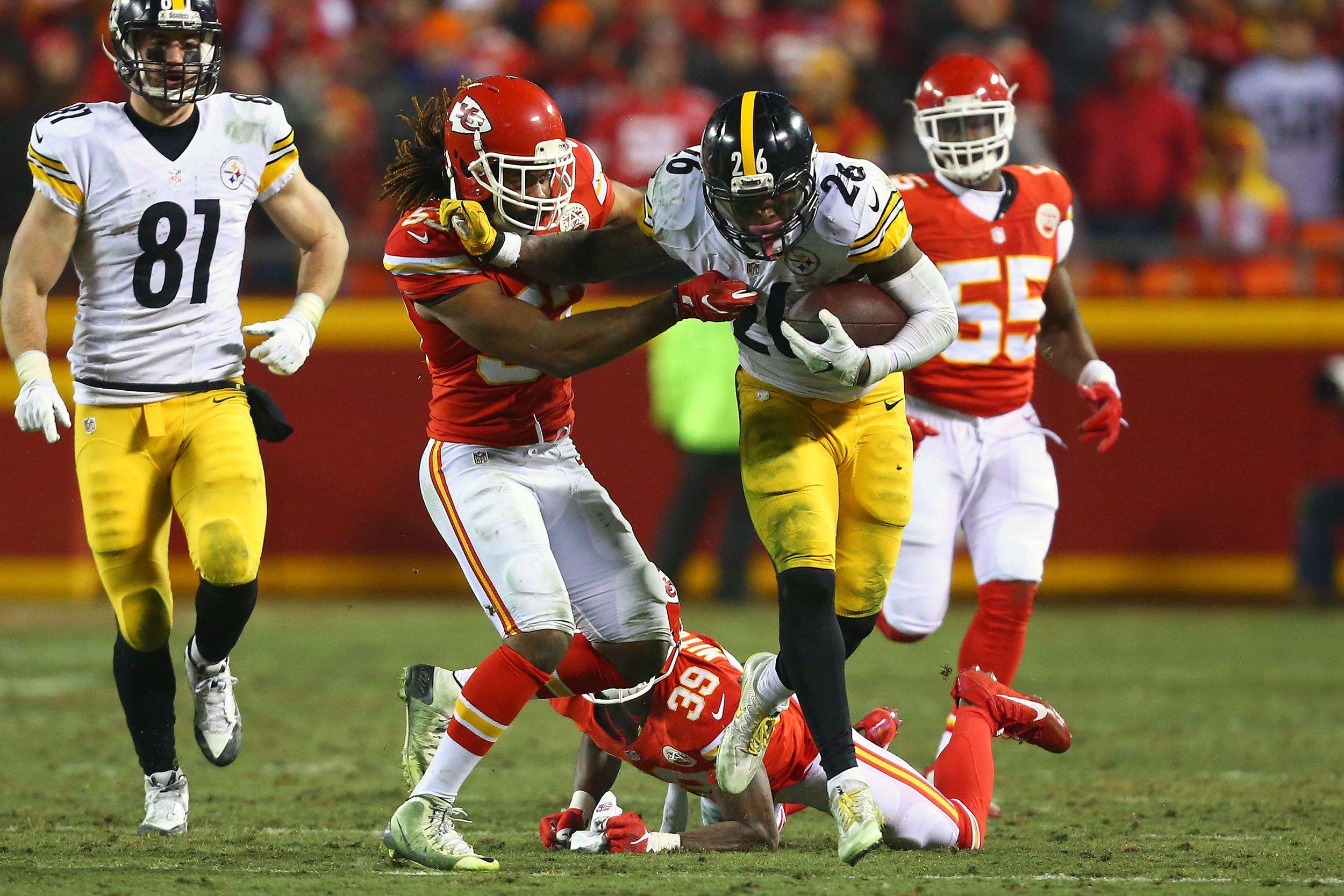
It’s almost always something with the Pittsburgh line, but all the key pieces are available right now, and this group has been manhandling teams late in the season. Bell’s production (170 rushing yards Sunday) speaks for itself, and the Steelers allowed just two pressures against a Chiefs pass rush that includes Tamba Hali and Justin Houston. Facing a Patriots defense without any stars among its front four, Pittsburgh should have a distinct edge.
10. Packers safety Micah Hyde played like a man possessed in Green Bay’s win. Hyde’s final line: one sack, two passes defensed, and an interception. The sack helped stall the Cowboys’ opening drive, which had already reached the Green Bay 40-yard line following two easy completions. The interception — a perfect read on a run-pass option that Dallas had used in the first meeting between these teams in Week 6 — thwarted a drive that had made its way to the Packers’ 19-yard line.
11. This week in NFL players, they’re absolutely nothing like us: I mean, c’mon.